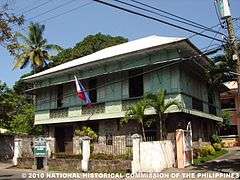Bonifacio Trial House
| Bonifacio Trial House | |
|---|---|
| Bahay na Pinaglitisan kay Andres Bonifacio | |
 The house of Teodorico Reyes in Maragondon, Cavite where Andres Bonifacio and his brother Procopio were tried by a court-martial in May 1897. | |
.svg.png) | |
| Alternative names | Teodorico Ancestral House |
| General information | |
| Status | National Historical Landmark |
| Type | Mansion |
| Architectural style | Bahay na Bato |
| Town or city | Maragondon, Cavite |
| Country | Philippines |
| Coordinates | 14°16′27″N 120°44′13″E / 14.274281°N 120.736977°ECoordinates: 14°16′27″N 120°44′13″E / 14.274281°N 120.736977°E |
| Current tenants | National Historical Commission of the Philippines |
| Owner | Government of the Philippines |
| Technical details | |
| Material | Stones, Bricks, and Wood |
| Floor count | Two |
The Teodorico Reyes Ancestral House, more commonly known as the Bonifacio Trial House, is a historic house and museum in Maragondon, Cavite, Philippines. It was built in 1889 and served as a military court, wherein it has been a witness to the trial of Andres Bonifacio in 1897.
History
The plan for a new government was established since the emergence of the revolution in August 23, 1896. Its aim was to unite the Katipuneros under a single leadership. The Magdalo faction nominated Emilio Aguinaldo while Magdiwang faction retained Bonifacio, who was the "Supremo" of the Katipunan. On March 22, 1897, the revolutionary government was established at the Tejeros Convention. Emilio Aguinaldo was the president of the new government while Bonifacio was declared as the Minister of Interior. However, Daniel Tirona of Magdalo, questioned the Bonifacio's qualifications for the said position. Upon his authority as the presiding officer, he declared all the proceedings null and void.[1]
Bonifacio, then, established his own government in Naic, Cavite. He was arrested for refusing the revolutionary government, upon the orders of Emilio Aguinaldo, at Indang, Cavite. His wife, Gregoria de Jesus, and his brother, Procopio, was also arrested. Andres Bonifacio was brought to a military court in Maragondon for a pre-trial hearing. On May 5, 1897, the brothers of Bonifacio were charged by the court with treason and sedition. On May 6, 1897, they were sentenced with death penalty.[1]
His brothers were brought by Major Lazaro Macapagal to Mount Tala on May 10, 1897. As soon as they reached Hulog, a barrio within the vicinity of Mount Nagpatong, Major Makapagal opened his sealed orders, upon Bonifacio’s insistence. The order revealed that severe punishment awaits for him if he would fail to execute the two brothers of Andres Bonifacio. The death of the Father of the Revolution, Andres Bonifacio, still remains to be controversial at present.[1]
Present condition
The house has been converted into a museum. The Museo ng Paglilitis ni Andres Bonifacio was formally inaugurated on November 28, 2014. Arnel Paciano D. Casanova, president and presiding Head Officer of the Bases Conversion and Development Authority, was the guest speaker of the event. It houses life-size dioramas commemorating the trial scene of Andres Bonifacio.[2]
Marker from the National Historical Commission of the Philippines
| Where Bonifacio was court-martialled |
|---|
| IN THIS HOUSE, ERECTED IN 1889. BY ITS OWNER, TEODORICO REYES, ANDRES BONIFACIO, FOUNDER OF THE KATIPUNAN, WAS TRIED WITH HIS BROTHER, PROCOPIO. MAY 1897, BY A COURT-MARTIAL HEADED BY BRIGADIER-GENERAL MARIANO NORIEL. HE WAS SHOT, MAY 10, 1897, AT MT. BUNTIS.[3] |
References
- 1 2 3 "Bonifacio Trial House". National Historical Commission of the Philippines. Retrieved 27 Dec 2014.
- ↑ Five Places that Bear Witness to Philippines Independence, PropertyAsia PH, 10 June 2016, Retrieved: 27 June 2016.
- ↑ Historical Markers: Regions I-IV and CAR. National Historical Institute. 1993.
External links
![]() Media related to Bonifacio Trial House at Wikimedia Commons
Media related to Bonifacio Trial House at Wikimedia Commons